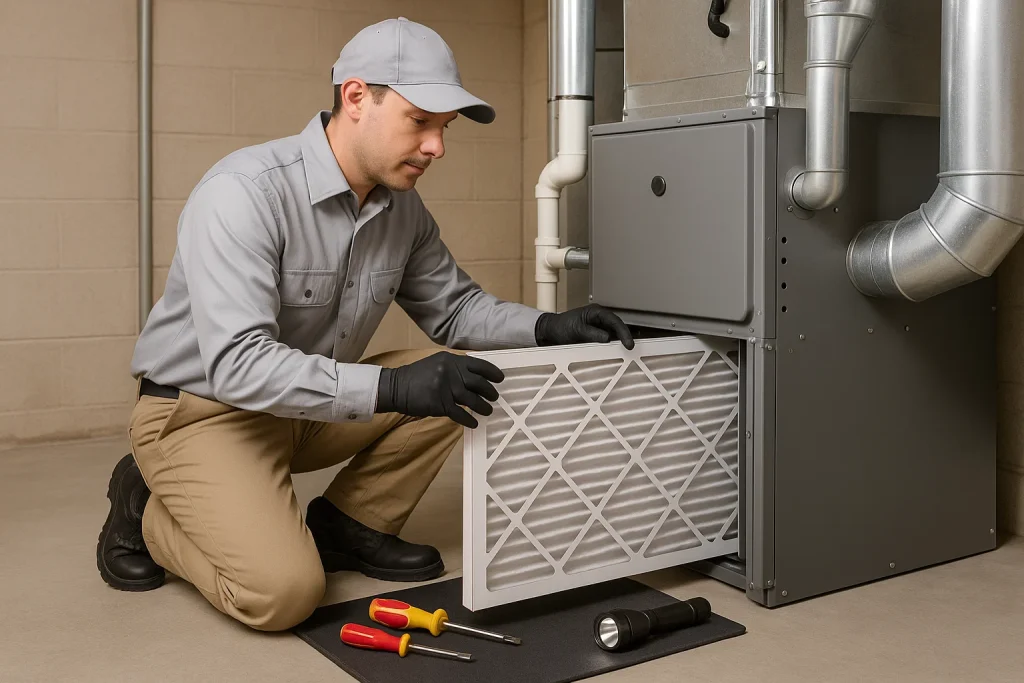Indoor air quality (IAQ) plays a huge role in your family’s health and comfort. Poor air quality can aggravate allergies, asthma, and respiratory issues, and it can make your home feel stuffy and unpleasant.
The good news? You don’t need to spend a fortune on expensive air purifiers or remodeling projects to breathe cleaner, fresher air. With a few affordable and simple steps, you can significantly improve the air inside your home and create a healthier living environment.

1. Change Your Air Filters Regularly
One of the most cost-effective ways to improve your indoor air quality is by changing your HVAC system’s air filters on schedule. Filters trap dust, pollen, pet dander, and other airborne particles, preventing them from circulating throughout your home.
- Replace standard fiberglass filters every 30 days.
- Higher-quality pleated filters may last up to 90 days but check monthly during heavy usage.
- Homes with pets, smokers, or allergy sufferers might require more frequent changes.
Dirty filters reduce airflow, strain your HVAC system, and let contaminants recirculate, so staying on top of filter changes is a simple way to breathe easier.
2. Use Natural Ventilation Whenever Possible
Fresh air from outside is one of the best natural ways to reduce indoor air pollutants. Opening windows and doors to let in a breeze helps dilute indoor contaminants and flush out stale air.
- Aim to ventilate your home for 10 to 15 minutes a day, weather permitting.
- Use exhaust fans in kitchens and bathrooms to remove moisture and odors.
- Cross-ventilate by opening windows on opposite sides of your home to create airflow.
Be mindful of outdoor air quality, especially on high-pollen or high-ozone days. On those days, keep windows closed and rely on other indoor methods.
3. Control Humidity Levels
Too much moisture in the air creates the perfect environment for mold, mildew, and dust mites – all of which can worsen indoor air quality and trigger health problems. Keeping your home’s humidity between 30% and 50% reduces these risks.
- Use affordable hygrometers (humidity meters) to monitor indoor levels.
- Run dehumidifiers in damp areas like basements and bathrooms.
- Fix leaks and seal any sources of water intrusion promptly.
Maintaining balanced humidity helps your home feel more comfortable and protects your indoor air quality.
4. Keep Your Home Clean and Dust-Free
Dust and allergens accumulate quickly and worsen air quality if left unchecked. Regular cleaning keeps these pollutants under control.
- Vacuum carpets and rugs at least once a week using a vacuum with a HEPA filter.
- Dust surfaces with a damp cloth to trap particles instead of spreading them into the air.
- Wash bedding, curtains, and soft furnishings regularly in hot water to remove dust mites and allergens.
- Remove clutter and items that collect dust.
Keeping floors and surfaces clean reduces allergens that can irritate your respiratory system.
5. Avoid Indoor Pollutants and Use Safe Cleaning Products
Many household products release volatile organic compounds (VOCs) and other harmful chemicals into the air, which degrade indoor air quality.
- Choose fragrance-free, low-VOC, or natural cleaning products.
- Avoid smoking indoors, which introduces harmful pollutants.
- Use non-toxic paints and finishes for home projects.
- Store chemicals and solvents outside of living areas or in well-ventilated spaces.
To schedule your indoor air quality service, contact Premier HVAC Services today!

